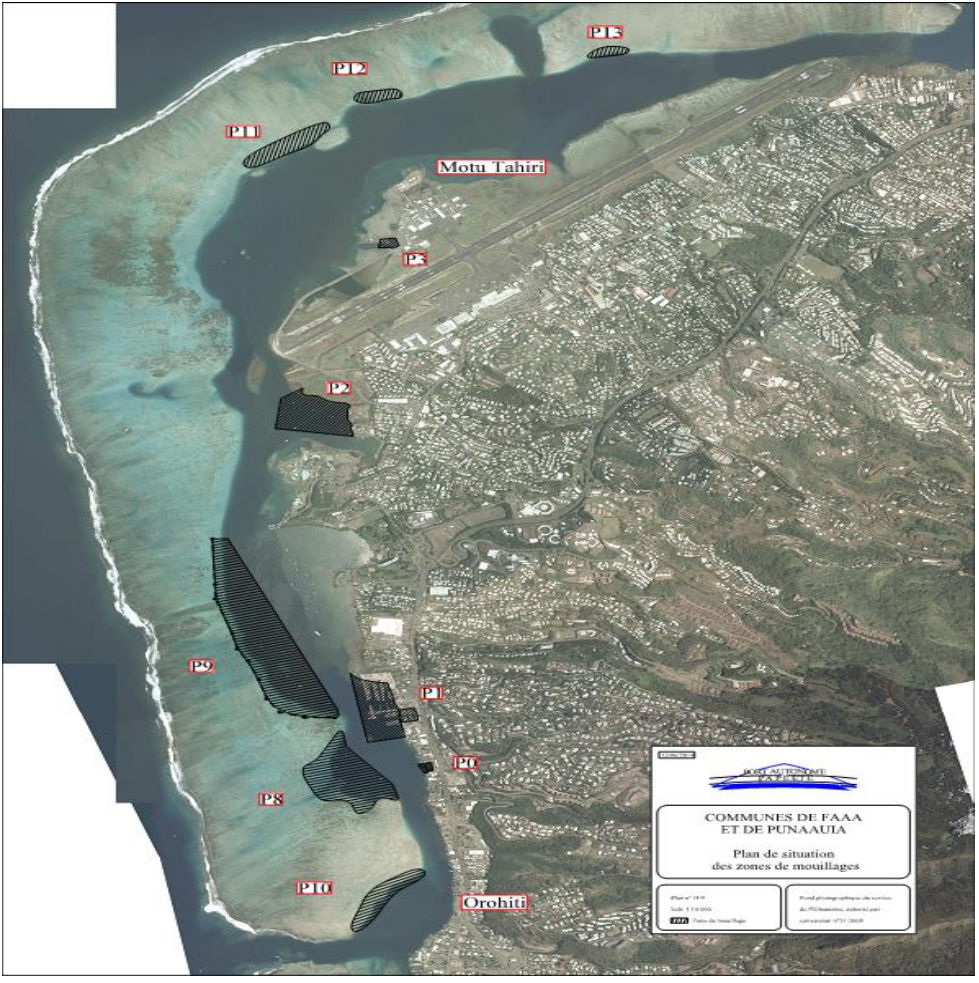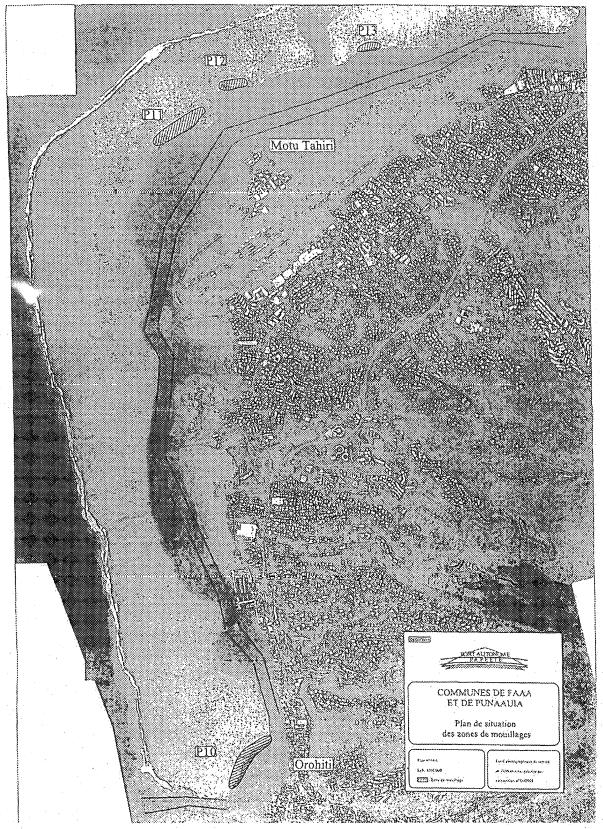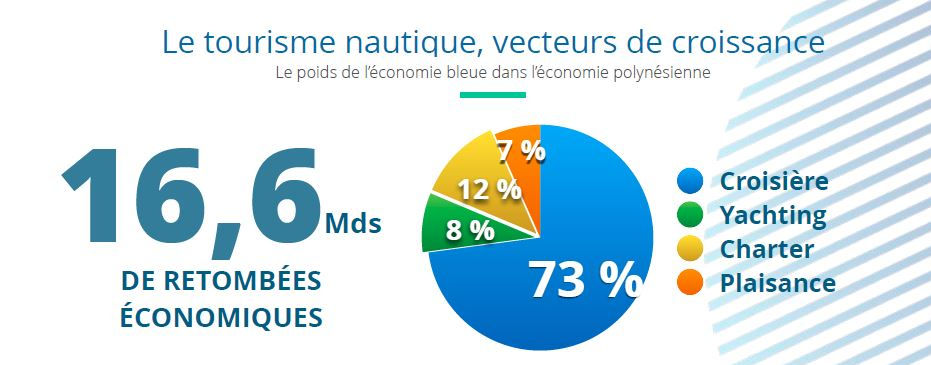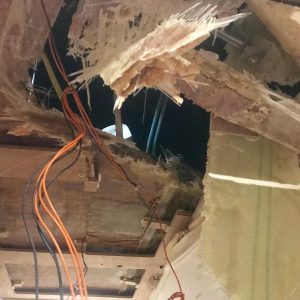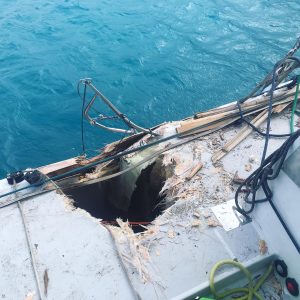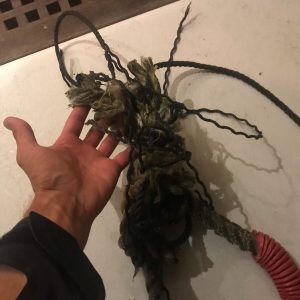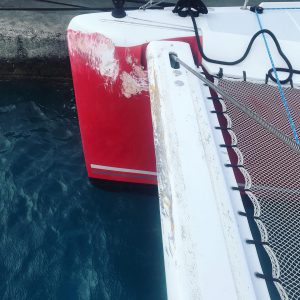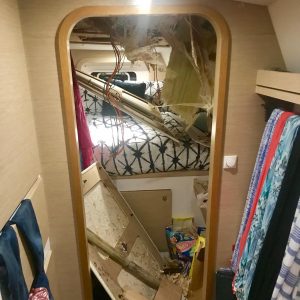In summary
All vessels over 10 m. and under 20 m. must anchor in the areas dedicated to the authorized anchorage. Beyond 20 m. Ships must use the "Yacht anchorage areas".
There is an obligation to declare all vessels on arrival and departure from Bora Bora.
Two areas are "free": the Faanui area and the Hitiaaa area. The anchorage is strictly limited to five vessels. The period of stay of vessels in this area may not exceed 36 hours.
The other five zones are granted to Bora Bora Mooring Services, which has installed 77 BBMS-referenced and numbered buoys to date (November 18, 2019) and plans to install 105. The night is 3000 CFP/day. According to other sources it would be $50 for 3 days and $100 for a week.
For all requests for services: waste management, drinking water, and emptying or for all buoy reservations, please contact : Francis HAZLEHURST, BBMS controller agent, Tel: 89 44 08 888 or by email: francis.bbms@gmail.com and VHF 9
For water, the points of sale for prepaid cards are: Matira Jet Tours activity office, next to the Air Tahiti agency, at Bloody Mary's restaurant or BBMS agency.
We asked Bora Bora Mooring Service, to produce his insurance. He replied (18/11/2019) that he was insured by Helvetia. The broker who manages all our insurances is the company ASSURCARE, represented by Mr Hervé ROIGNANT whose contact details are: email: hroignant@assurecare.of or BP 41156 - 98713 Papeete - Tel. : +689 40 836 200.
In our opinion, the rates are very high (3000 CFP /day) and the service low. Waste management but no access to land, fresh water and black water management not included, schedule of revisions of buoys not published.
Other cruisers testify:
We just spent a fabulous week in Bora Bora with our family. Thought you may want an update on the situation there. When you arrive make sure you pick up a buoy that has the BBMS mark on it, so you can be sure it is an insured one. Other moorings are not. A friendly young man named Francis will come by to collect their fees. $50 for 3 days or $100 for a week. This includes trash pick up MWF week days. The map he gave us shows where all of their moorings are located. Stay on a different one each night or the same one, does not matter. We were allowed to anchor (the yacht) for a few hours at dive/snorkel spots, but not overnight. We also tied up at the city quay to go shopping and put our guests on the airport ferry. All moorings we picked up were in superb condition including chafe gear on the loop. He says they are inspected every 6 months or sooner if someone wraps a prop. Francis was raised on a sailboat and speaks fluent English, French and Tahitian. He understands the needs of cruisers. Bora is quite cleaned up of the derelict boats we saw three years ago. Putting their best foot forward to keep it beautiful. I would not want to spend this kind of money to moor every where, but Bora is their top tourist destination.
Verbatim
ARRETE No. 2442 CM of November 22, 2018 regulating the mooring of ships in the inland waters of the island of Bora Bora.
AIOR DAM1822285AC-1
The President of French Polynesia,
On the report of the Minister of Housing and Land Development, in charge of inter-island transport,
In view of the organic law No. 2004-192 of 27 February 2004 amended to establish the autonomy status of French Polynesia, together law No. 2004-193 of 27 February 2004 complementing the autonomy status of French Polynesia;
In view of Order 650 PR of 23 May 2018 appointing the Vice-President and Ministers of the Government of French Polynesia, and determining their functions;
Given the penal code;
In view of Law 83-581 of 5 July 1983 on the safeguarding of human life at sea, habitability on board ships and the prevention of pollution, together Decree 84-810 of 30 August 1984 amended relating to the safeguarding of human life at sea , pollution prevention, safety and ship certification, as well as the 23 November 1987 ship safety order and its annexed regulations;
In view of Law 61-1262 of 24 November 1961 relating to the police of maritime wrecks, together Decree 61-1547 of 26 December 1961 amended fixing the regime of maritime wrecks;
Given the environmental code of French Polynesia;
In view of the 2004-34 APF deliberation of 12 February 2004 amended on the composition and administration of the public domain in French Polynesia;
In view of the deliberation No. 78-124 of 27 July 1978 amended by the regulation of traffic in the lagoons of French Polynesia;
In view of the request of the municipality of Bora Bora by mail MT/047651/DGS/COM/GTS/MT of 27 October 2018;
Considering the certificate "Blue Flag Label" awarded for the title of the year 2018 to the municipality of Bora Bora;
Considering the imperatives of protecting the environment as well as the safety of navigation and traffic in the inland waters of the island of Bora Bora;
Considering the need to ensure the harmonious coexistence of users in the maritime public domain;
The Council of Ministers, having deliberated in its meeting on 20 November 2018,
Stop it:
CHAPTER I - APPLICABLE GENERAL REGLES IN BORA BORA Island
Article Ler.— Definitions
For the purposes of this order, it means:
parking: immobilizing the vessel in an appropriate technical procedure, for a fixed period of time, and after authorisation duly issued by the competent authority;
anchoring: stopping the vessel in an appropriate manner, either by means of an anchor (ship's apparals) or by a permanent and fixed mooring device (buoy, dead body, ecological anchorage, .),
authority managing the dedicated area: the authority responsible for implementing the provisions of this decree, in particular with regard to management, requests for access to a dedicated area and parking.
Art. 2.— Object
Unless otherwise stated, in the inland waters of the island of Bora Bora, the mooring of vessels of a length greater than or equal to ten (10) metres or whose stay is greater or equal to a duration of twenty-four (24) hours is strictly prohibited outside dedicated to authorized mooring areas.
The delimitation of the dedicated areas is specified in Article 4 . and is included in the plans attached to this order.
The general conditions of use of areas dedicated to authorized anchorage, on anchor or on a mooring facility, are defined by this order.
The mooring of any vessel, for any length of time, is strictly prohibited in shipping channels.
Art. 3.- Exemptions
The prohibitions and requirements of this order are not enforceable against vessels and boats on a public service mission or engaged in a person rescue and asset rescue operation, or other vessels in the event of force. Major.
C ITRE II - APPLICABLE REGLES IN DEDIEES ZONES IN MOUILLAGE
Art. 4.- Delimitation of zones - dedicated to authorized mooring
Within the areas dedicated to authorized mooring, ships are anchored or on a light anchorage installation when the area has been authorised by the competent authority.
A - Areas dedicated to anchoring vessels of a reference length of 20 metres or more.
Only anchor anchoring of vessels of a reference length greater than or equal to 20 metres is permitted at the following points:
B - Area dedicated to anchoring vessels with a reference length of less than 20 metres.
Only the mooring of vessels with a reference length of less than 20 metres is permitted at the following points.
The perimeter of each zone is determined by the reference points indicated by area.
(1) The delimitation of the Nunue Bay area is defined by the following points:
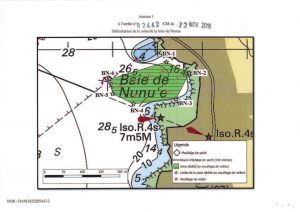
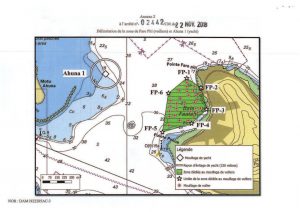
(3) The delimitation of the Faanui area is defined by the following points:
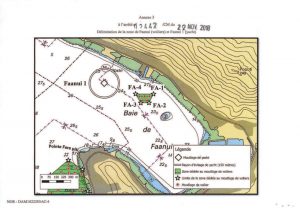
In this area, the mooring of ships is strictly limited to five (5) vessels.
The length of stay of the ships in this area may not exceed thirty-six (36) hours.
(4) The delimitation of the Hitiaa area is defined by the following points:
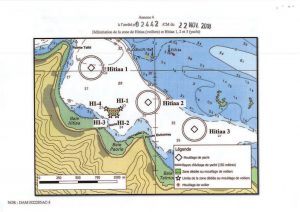
In this area, the mooring of ships is strictly limited to five (5) vessels.
The length of stay of the ships in this area may not exceed thirty-six (36) hours.
(5) The delimitation of the Motu Fareone area is defined by the following points:
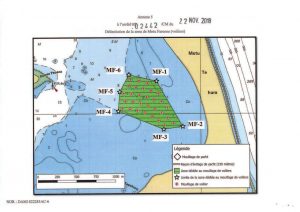
(6) The delimitation of the area south of Povai Bay is defined by the following points:
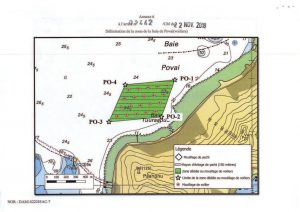
(7) The delimitation of the area west of the Toopua motu is defined by the following points:

The geographic coordinates defined in Article 4 are placed in the WGS84 geodesic system in decimal degrees and minutes.
The delimitation of the authorized dedicated mooring areas is represented in annexes of this decree, available to the Polynesian Directorate of Maritime Affairs (DPAM) and on the website www.maritime.gov.pf and www. ervice-public. p f/dp am
Art. 5.— Signage of mooring areas
The signage for each area dedicated to the authorized mooring area is put in place by the area manager and must comply with the requirements of the authority responsible for the safety of navigation and traffic in inland waters.
The technical signalling device is adapted to the nature of the seabed.
The authorized manager of the area dedicated to authorized mooring is obliged to inform the competent authority without delay of any changes in the signalling situation.
Art. 6.— Access and navigation rules within mooring areas
Access to dedicated areas is permitted for vessels in a state of navigation, as well as those in danger or in a state of damage.
Access to dedicated areas by vessels in danger or in a state of damage, is allowed only for a limited stay, justified by the circumstances.
Access and traffic within areas dedicated to authorized anchorage are carried out in accordance with navigation rules, including those set by international regulations to prevent collisions at sea.
Within these dedicated areas, the maximum speed of ships is set at 3 knots.
Except in case of force majeure, ships are only allowed to move within the dedicated area to access or leave a berth.
Art. 7.— Entry and Departure Statement
Any vessel calling in one of the areas dedicated to authorized anchorage is required, upon arrival, to make itself known to the authorized manager and to make a declaration of entry by any appropriate means (telephone, fax, e-mail, VHF) for Transmit:
A photocopy of the ship's documents (registration certificate, identification of the ship's flag and owner);
A photocopy of the owner's passport or, if necessary, the ship's user;
The specific contact details of the owner, or if any, of the ship's user (phone numbers, email);
The scheduled date for departure from the mooring area. If this date is changed, an adjustment statement is made without delay to the authorized manager of the authorized area;
A departure statement is made before the ship is finally discharged from the dedicated area.
Art. 8.— Use of authorized mooring areas
The master of any vessel must ensure that his vessel, at all times and under any circumstances, does not cause any damage to other vessels or interfere with the use of the mooring area authorized by other users.
If necessary, all precautions, manoeuvres or movements, location changes prescribed by the qualified manager, must be respected or executed, especially when they are deemed necessary to facilitate the movement of other vessels or ensure the safety of navigation and traffic in the inland waters of the island of Bora Bora.
Art. 9.— Hygiene and pollution
Ships anchored in one of the areas dedicated to authorized mooring may not discharge, dump or allow their household waste and waste of any kind to flow into the water, or contaminated or oil-laden water, oils or products. Toxic. Any rejection to the sea is strictly forbidden.
All waste must be deposited in onshore facilities provided for this purpose. The discharge of wastewater is subject to special regulations.
It is forbidden to carry out any work on ships at anchor in areas dedicated to authorized mooring.
Repair, fairing operations, product applications or paints.
Art. 10.— Removing marine wrecks and abandoned ships
Any vessel staying in the areas dedicated to authorized anchorage must be kept in a good state of maintenance, buoyancy and safety.
If the authorized manager finds a wreck or a vessel is in a clear state of abandonment or lack of maintenance, and has, in whole or in part, a dangerous nature for navigation, fishing or the environment, access to a port or stay in a port, which may sink or cause damage to ships, surrounding structures or the environment, it informs the competent authority as soon as possible to proceed with the owner's notice to take any necessary to remove the dangerous nature of the vessel.
In the event of inaction by the vessel owner within the allotted time, the competent authority automatically proceeds with the operations necessary at the owner's expense and risk to put an end to the risk of danger or damage to the public maritime domain.
For the removal of the wreckage, the owner of the vessel complies with the requirements issued by the competent authority.
Art. 11.— Prohibition of the practice of water, water or underwater activities in the perimeter of areas dedicated to authorized mooring.
Within the boundaries of the areas dedicated to authorized mooring, the practice of any nautical, aquatic or underwater activity is strictly prohibited for reasons of navigational safety.
Art. 12.— Public display and information
This order and its annexes regulating the mooring of ships in the inland waters of Bora Bora Island are the subject of information by way of signage in the town hall, and a signage by information sign in French, in Tahitian and in English, located on the outskirts of dedicated areas, close enough, and in an appropriate place to ensure its accessibility and visibility by all users.
Art. 13.— Sanctions
Without prejudice to the penalties relating to the preservation of the public domain, and in accordance with Article 131-13 of the Penal Code:
(1) Is punished with the fine for 4th class tickets:
Any vessel mooring referred to Article 2 outside the authorized mooring areas defined in Article 4, unless authorized;
Any vessel mooring of a reference length greater than or equal to 20 metres outside the areas reserved for them and which are defined in Article 4-A;
Any vessel mooring with a reference length of less than 20 metres outside the areas reserved for them and which are defined in Article 4-B;
Any violation of the vessel traffic rules under article 6.
(2) The fine for 2nd class tickets is punishable:
Failing to make Article 7 statements;
Any refusal to carry out the precautions or requirements in the second paragraph of Article 8;
All work or operations carried out on vessels in violation of Article 9;
One of the activities prohibited by Article 11 in the Article 4 areas;
(3) The release, release or discharge of any pollutant in the waters is punishable by the French Polynesian Environmental Code (LP). 3131-1).
Art. 14.— Violations Report
Without prejudice to the powers exercised by officers and judicial police officers and sworn officers of the commune of Bora Bora, violations of the provisions of this order are found by minutes drawn up by the officers Polynesian Maritime Affairs Directorate.
Art. 15.— The Minister of Housing and Land Development, in charge of inter-island transport, the Minister of Green Economy and the Domain, in charge of mines and research, the Minister of Culture and the Environment, in charge of crafts, and the Minister of Equipment and Land Transport are each responsible for the execution of this order, which will be published in the Official Journal of French Polynesia.
Made in Papeete, November 22, 2018.
For the absent President:
The Vice-President,
Teva ROHFRITSCH.
By the President of French Polynesia:
The Minister of Housing
planning,
Jean-Christophe BOUISSOU.
The Minister of the Green Economy
and the field,
Tearii ALPHA.
For the Minister of Culture
and the absent environment:
The Minister of Modernization
Administration,
Tea FROGIER priscille.
For the Minister of Equipment
and land transport absent:
The Minister of Housing
planning,
Jean-Christophe BOUISSOU.
The order in pdf: Order No. 2442 CM of 22-11-2018






